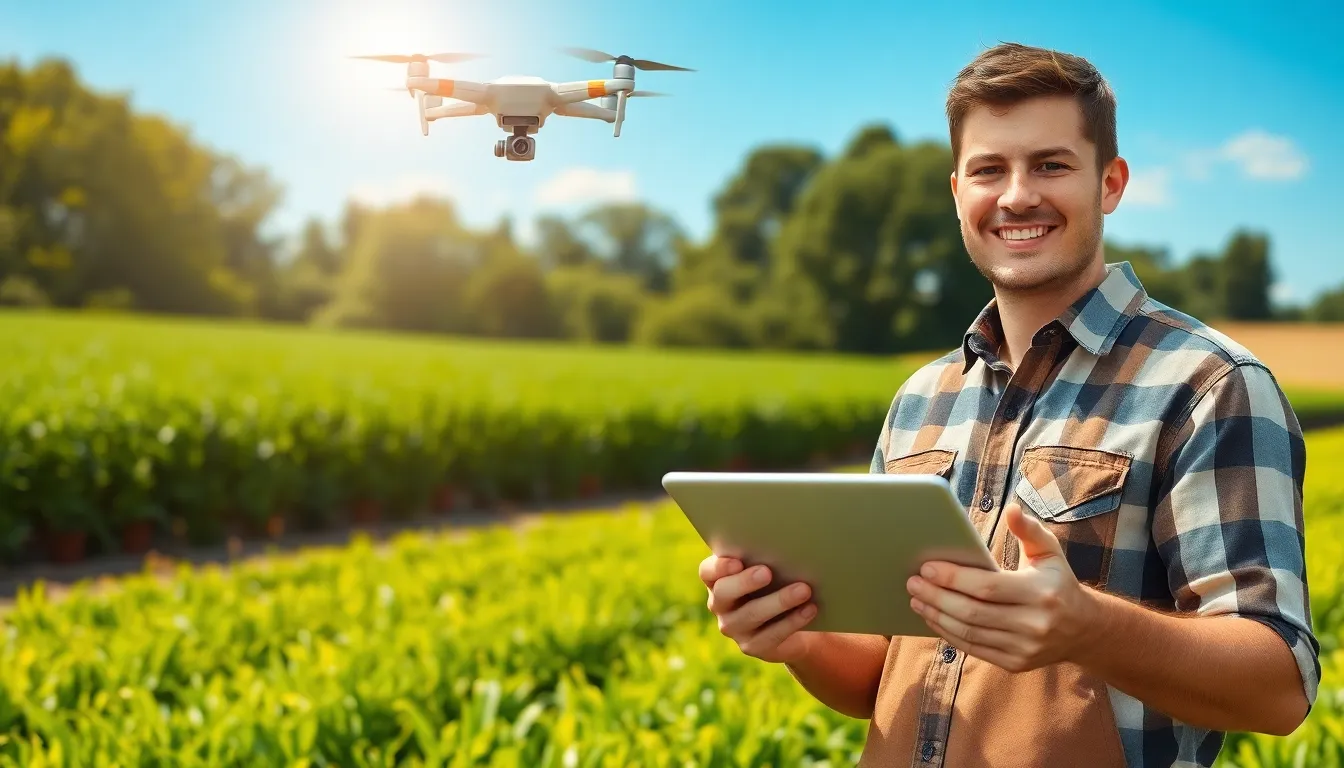In a world where crops can’t text you when they’re thirsty, AI crop monitoring swoops in like a superhero. Imagine a tech-savvy sidekick that keeps an eye on your fields, ensuring every plant gets the TLC it deserves. With the power of artificial intelligence, farmers can now predict pest invasions and track moisture levels faster than you can say “fertilizer.”
Gone are the days of guessing and hoping for rain. This innovative approach is not just about boosting yields; it’s about making farming smarter, easier, and a bit more fun. So, whether you’re a seasoned pro or a weekend warrior, AI crop monitoring could be the secret weapon to transform your agricultural game. Who knew farming could be this high-tech and entertaining?
Table of Contents
ToggleOverview of AI Crop Monitoring
AI crop monitoring utilizes advanced technology to enhance agricultural practices. This approach incorporates machine learning algorithms to analyze vast amounts of data, enabling timely decision-making. Farmers leverage satellite imagery and drones to gain real-time insights into field conditions. Benefits include improved pest prediction and moisture assessment, which leads to precise resource allocation.
Automated systems provide alerts concerning crop health, enabling proactive measures against diseases or pests. Enhanced visibility into soil health ensures farmers address issues swiftly, maximizing yield potential. Predictive analytics dive deeper into climatic factors affecting harvests, offering farmers tailored strategies that fit their unique circumstances.
Data collected through AI tools supports rigorous analysis, allowing stakeholders to evaluate the effectiveness of different agricultural techniques. Farmers can make informed decisions to improve their operational efficiency. The technology adapts continuously, learning from new data inputs to refine its predictions and recommendations.
Integration of AI in crop monitoring fosters collaboration among agricultural experts and farmers. Regular updates and feedback loops ensure that the information remains relevant and actionable. This synergy promotes sustainable practices that benefit the environment and enhance profitability.
Research estimates that utilizing AI in agriculture can increase crop yields by up to 30%. As awareness of these benefits grows, adoption rates of AI technologies continue to rise among farmers worldwide. This alignment between technology and agriculture marks a significant evolution in farming practices, promoting a smarter approach to food production.
Benefits of AI Crop Monitoring
AI crop monitoring presents several key advantages that fundamentally enhance agricultural practices. By leveraging advanced technology, farmers can optimize their operations and tackle challenges efficiently.
Increased Efficiency
Efficiency in farming improves significantly with AI crop monitoring. Automated systems analyze data to streamline tasks such as irrigation and planting schedules. Utilizing real-time information about weather patterns and soil conditions enables farmers to make quick, informed decisions. By reducing manual labor and minimizing waste, AI technology also helps save costs. Resulting improvements can lead to enhanced overall productivity, benefiting both small and large-scale farmers.
Precision Agriculture
Precision agriculture relies heavily on AI crop monitoring techniques. Drones equipped with sensors capture detailed imagery of fields, identifying variations in crop health. Specific algorithms process this data to pinpoint areas requiring attention, allowing for targeted interventions. Water, nutrients, and pest management strategies become tailored to individual crop sections, resulting in more effective resource use. Research shows that these precision methods can significantly boost yields, supporting sustainable farming practices that adapt to environmental factors.
Technologies Used in AI Crop Monitoring
AI crop monitoring employs various advanced technologies to enhance agricultural efficiency. These technologies play a crucial role in supporting farmers in their daily operations.
Remote Sensing
Remote sensing uses satellite imagery and drone technology to gather valuable data about crop conditions. High-resolution images allow for the assessment of crop health and moisture levels across large areas. This data enables farmers to detect anomalies, such as pest infestations or nutrient deficiencies. Satellite sensors measure the Earth’s reflected radiation, helping gauge vegetation vigor through indices like NDVI. Drones provide close-range perspectives, capturing detailed images that reveal crop variability. Such insights lead to timely interventions, ensuring optimal resource allocation and management.
Machine Learning Algorithms
Machine learning algorithms process vast amounts of agricultural data to derive actionable insights. These algorithms analyze satellite and drone imagery, enabling predictive analytics to forecast potential issues. They identify patterns in historical data, improving pest prediction and disease risk assessments. Specific algorithms can also optimize irrigation schedules, ensuring crops receive adequate water based on real-time conditions. Agriculture benefits immensely from these algorithms, as they enhance decision-making processes. Research indicates that machine learning can increase accuracy in yield predictions, helping farmers implement tailored strategies.
Case Studies and Applications
AI crop monitoring showcases its active role in modern agriculture, illustrating significant advancements in efficiency and sustainability.
Successful Implementations
Numerous farmers have adopted AI crop monitoring systems, achieving remarkable results. For instance, a farm in California integrated drone technology to assess crop health regularly. Implementing this system led to a 25% increase in yield by pinpointing areas needing immediate attention. Another example comes from a soybean farmer in Brazil, who utilized machine learning algorithms for pest prediction. This integration resulted in a remarkable 30% reduction in pesticide use while maintaining crop health. By harnessing such technologies, farmers enhance productivity and minimize environmental impact.
Comparative Analysis with Traditional Methods
Comparing AI crop monitoring with traditional methods reveals clear advantages. Conventional farming often relies on visual inspections and historical data to assess crop health. This approach can be time-consuming and prone to inaccuracies. In contrast, AI systems leverage real-time data gathered from drones and sensors to deliver precise insights. Traditional methods may lead to delayed responses to issues like pests or diseases. Conversely, AI technologies allow for rapid decision-making, enabling farmers to take proactive measures. Research shows that AI monitoring can improve efficiency by up to 40% compared to traditional techniques, signifying a pivotal shift in agricultural practices.
Challenges and Limitations
Despite the advantages of AI crop monitoring, several challenges exist. Data accuracy plays a critical role; inaccurate satellite imagery or sensor readings can yield misleading results, affecting farmers’ decisions. High costs associated with technology adoption deter small-scale farmers from implementing AI solutions, limiting its benefits to larger operations.
Scalability poses another issue; solutions effective on small farms may not translate well to larger agricultural landscapes. Connectivity challenges also impact rural areas, with limited internet access hindering real-time data updates and cloud-based solutions. Farmers’ reliance on technology raises concerns about cybersecurity; potential data breaches may expose sensitive information related to crop management.
Training is essential, as many farmers may lack the technical expertise needed to utilize AI tools effectively. Complex algorithms and machine learning models require understanding that not all farmers possess. Resistance to change can limit the willingness of some to adopt new technologies, preferring traditional farming methods instead.
The integration of various data sources presents another hurdle. Combining data from drones, sensors, and satellite imagery may complicate analysis. Compatibility issues between different technology platforms can further hinder effective monitoring and decision-making.
Lastly, ethical considerations arise regarding data privacy and ownership. The question of who controls the data collected and how it is used becomes increasingly relevant. As the agricultural sector continues to evolve, addressing these challenges remains essential to fully harness the potential of AI crop monitoring.
Conclusion
AI crop monitoring is revolutionizing agriculture by enhancing efficiency and productivity. With its ability to predict pest invasions and monitor essential moisture levels, farmers can make informed decisions that lead to healthier crops and increased yields. The integration of advanced technologies like drones and machine learning algorithms empowers farmers to adopt precision agriculture practices tailored to their specific needs.
While challenges remain, such as data accuracy and technology costs, the potential benefits of AI in farming are undeniable. As adoption rates rise and awareness grows, AI crop monitoring is set to play a pivotal role in shaping the future of sustainable agriculture. By embracing this technology, farmers can not only improve their operations but also contribute to a more resilient food system for generations to come.






